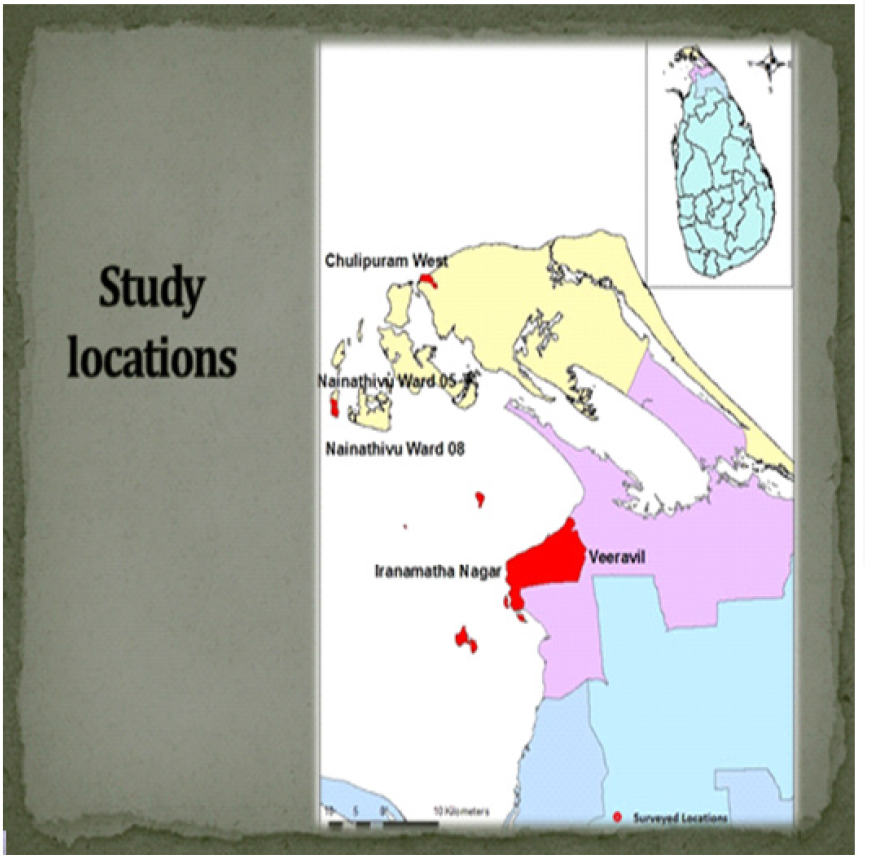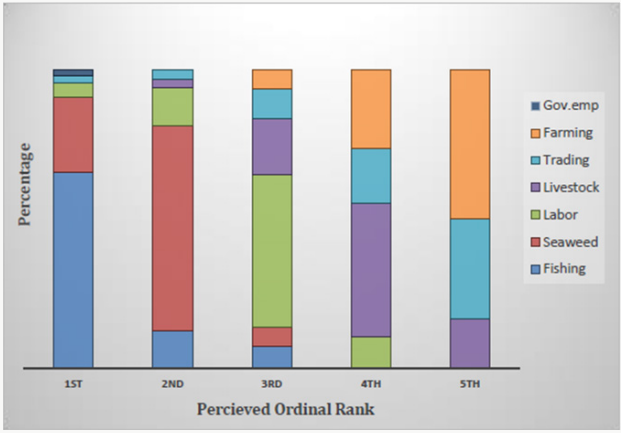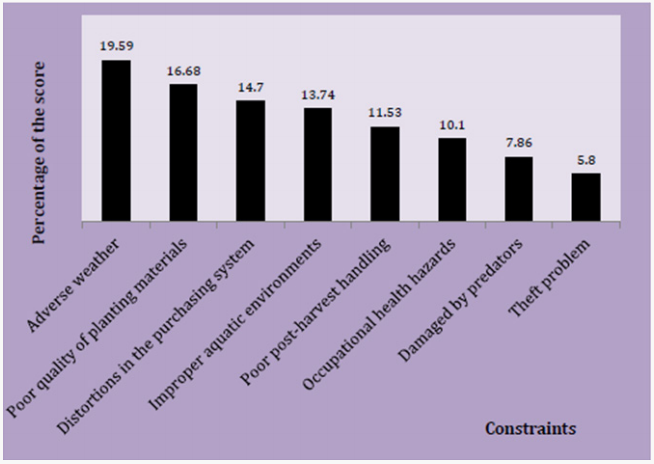Lupine Publishers | Current Investigations in Agriculture and Current Research
Seaweed cultivation is identified as a catalyst for social
progression in coastal communities. Despite the potentials, the seaweed
cultivation introduced to resettled coastal districts in Sri Lanka seems
not performing to the expectations owing to various reasons.
Farmers’ perspective as the leading stakeholders would facilitate the
understanding of such a complexity. Therefore, the study
attempted to assess the values and constraints related to seaweed
farming as perceived by the seaweed farmers. Two-stage
stratified random sampling technique was employed to draw a sample of
160 seaweed growers from the purposely-selected coastal
areas of northern Sri Lanka. A perceived ordinal ranking method was
exercised to assess the perceived importance, whilst Garrett’s
ranking technique to detect the judgment of the farmers about the
constraints. Next to fishing, seaweed farming received the highest
perceived importance of the respondents. Favourable income and
employment generation, the ability to easily manage with fishing,
supportive role in empowering women and the existence of a favourable
contract growing system were among the major causative
responses contributed to the perceived importance. Major constraints
identified in sea weed farming were adverse weather pattern
(19.6%), poor quality of existing planting materials (16.68%),
distortions prevailing in the purchasing mechanism (14.7%) and
improper aquatic environments (13.74%). Thus, the study concluded that
seaweed farming is perceived as an important livelihood
option for the coastal communities and developing strategies to mitigate
the impact of adverse environmental changes would
promote seaweed cultivation.
Keywords: Constraints; Perceived importance; Seaweed farming; Sri Lanka
Seaweed cultivation has become increasingly popular as one
of the most important economic activities that can be practiced
in the coastal regions. The potential role that seaweed could play
in rural development being as a catalyst of social progression
[1] by rendering extensive employment opportunities [2] to the
coastal communities has already been identified. Accordingly,
the government of Sri Lanka has introduced seaweed farming to
resettled coastal districts in the northern part of the country to
improve socio-economic conditions in vulnerable regions through
the promotion of sustainable livelihood development. However, the
available sporadic information in this regard imply that the level
of performance seems to be suppressed by issues such as harsh
weather conditions [3-5] and improper aquatic environments,
which were commonly associated with seaweed farming. In
this backdrop, assessing the value and constraints related to
seaweed farming as perceived by the beneficiaries would uncover
trustworthy, qualitative and in-depth information that would
otherwise not become known. Such information would be essential
for future planning by the policy makers for a better design to meet
the farmer needs and can be useful both to fine-tune and enhance
the effectiveness of the existing seaweed cultivation system.
This study was conducted in purposely-selected coastal areas
of Jaffna and Kilinochchi districts, located in the Northern Province
of Sri Lanka (Figure 1). Two-stage stratified random sampling
technique was employed to select 03 Divisional Secretariat (DS)
divisions and 04 Grama Niladhari (GN) divisions respectively and
finally to draw a sample of 160 seaweed growers. The required primary data were mainly collected through a structured and
pre-tested questionnaire, in-depth interviews and focus group
discussions. The perceived ordinal ranking method as previously
adopted by Crawford [6] was exercised to assess the perceived
importance of seaweed growers towards different livelihood
options, whilst Garrett’s ranking technique [7-9] was exercised to
detect the judgment of the farmers about the constraints faced by
them in seaweed cultivation.
The interviewees identified that the seaweed farming is instrumental in empowering women [13,15] within the study area. Further, it was reported that without being much disturbing to the primary economic activity, the seaweed farming can be easily integrated with conventional fishing. Moreover, it was identified that seaweed farming requires lesser time for its maintenance after planting and allows farmers to engage in other activities as well. Altogether, these major causative responses led to the perceived importance and will assist in promoting the seaweed cultivation within the study area. Apart from these major causes the provision of rapid return on investment, the requirement of simple farming techniques and an alternative for deprivation of terrestrial lands for cultivation also affected for the perceived importance towards seaweed farming.
The study identified that the buyers adopted a contract growing system as the purchasing mechanism of seaweed. Such mechanisms were further reported in the studies of Krishnan [3,17] and Hurdato (2013) related to seaweed farming. As identified by the study, low farm gate price, sporadic payments, and defective weighing processes have distorted (14.7) the qualities of the existing purchasing system. The respondents also viewed that the buyers regularly justify these low prices, highlighting the importance of technical provisions like raw materials and advisory support, which are mainly provided by them. Conversely, few growers believed that non-existence of layers of intermediaries and protection from time to time price fluctuations would still make the contract growing system more favourable.
The ideal aquatic environment provided in near-shore areas is favourable for sea weed farming. However, due to high competition and legal cut-offs imposed by the local authorities’ farmers haveshifted the cultivation to less fertile improper aquatic environments (13.74). Seaweed-farming locations were co-managed by coastal villagers and idled seaweed farms also contributed to this problem. Participants also indicated that seaweed cultivation locations away from the near-shore areas increased the overall production cost due to the expenses incurred for extra transportation.
Based on the logical interpretation of the findings, it can be concluded that seaweed farming is perceived as an alternative livelihood option for the coastal communities. This social acceptability implies the possibility of further expanding seaweed farming to other matching locations as a commercial enterprise. The adverse weather pattern was the major constraint perceived by the seaweed growers. In order to promote the existing system, the establishment of a weather damage relief program from the government, early warning system of sudden environmental changes and commercial level seaweed nurseries are recommended. Further, the collaborative action between key stakeholders is identified as a necessity to promote the seaweed industry.
Abstract
Keywords: Constraints; Perceived importance; Seaweed farming; Sri Lanka
Introduction
Methodology
Results and Discussion
Farmers’ perceived importance towards seaweed farming
Next to fishing, seaweed farming received the highest perceived importance of the respondents. Accordingly, sea weed farming was perceived by 94% of farmers as either first or second in importance (Figure 2). The reasons behind the perceived importance were satisfactory income and generation of employment, easily manageable nature with fishing, cooperative role in women empowerment and the prevailing promising contract growing system (Figure 2). Being an economically viable alternative livelihood option [10], seaweed farming has diversified the livelihood options of the farming communities and thereby has provided a stable annual average income, which improves household economic resilience [11] enabling a sustainable way of life. This finding is in conformity with the findings of Zacharia [12] and Tobisson [13] on the role of seaweed farming in coastal livelihood improvement. On the other hand, previous studies have identified the possibility of developing employment-incomeconsumption relationships related to the seaweed farming [2]. This employment potential [6,14] is highlighted by the participants and viewed that harvesting and initial preparation stages render extensive employment opportunities. Especially, the shallow water seaweed farming allows more involvement of women and renders more employment opportunities for women during initial preparation and harvesting stages.The interviewees identified that the seaweed farming is instrumental in empowering women [13,15] within the study area. Further, it was reported that without being much disturbing to the primary economic activity, the seaweed farming can be easily integrated with conventional fishing. Moreover, it was identified that seaweed farming requires lesser time for its maintenance after planting and allows farmers to engage in other activities as well. Altogether, these major causative responses led to the perceived importance and will assist in promoting the seaweed cultivation within the study area. Apart from these major causes the provision of rapid return on investment, the requirement of simple farming techniques and an alternative for deprivation of terrestrial lands for cultivation also affected for the perceived importance towards seaweed farming.
Constraints for seaweed farming
The results indicated that the adverse weather pattern (19.6%) is the major constraint faced by the seaweed farmers within the study area and obtained the highest rank. In conformity to the findings of Zamroni [3], the seasonal changes associated with monsoonal weather pattern is critically affecting the seaweed cultivation by limiting it to four cultivation seasons per year. Further, heavy rains and severe weather conditions like prolonged higher temperature periods regularly disturb the seaweed cultivation. These unfavorable changes would ultimately affect both quality and quantity [16] of seaweed harvest (Figure 3). Consisting with the findings of Zamroni [3], the poor quality of planting materials (16.68) obtained the second highest rank as a major constraint faced by the seaweed farmers. Farmers ordinarily use traditional self-propagation techniques using cuttings of the previous harvest. However, inferior strains created by overutilization of the old seaweed stocks may have negatively affected the growth rate and quality of seaweed and avoided growers from optimizing their yield.The study identified that the buyers adopted a contract growing system as the purchasing mechanism of seaweed. Such mechanisms were further reported in the studies of Krishnan [3,17] and Hurdato (2013) related to seaweed farming. As identified by the study, low farm gate price, sporadic payments, and defective weighing processes have distorted (14.7) the qualities of the existing purchasing system. The respondents also viewed that the buyers regularly justify these low prices, highlighting the importance of technical provisions like raw materials and advisory support, which are mainly provided by them. Conversely, few growers believed that non-existence of layers of intermediaries and protection from time to time price fluctuations would still make the contract growing system more favourable.
The ideal aquatic environment provided in near-shore areas is favourable for sea weed farming. However, due to high competition and legal cut-offs imposed by the local authorities’ farmers haveshifted the cultivation to less fertile improper aquatic environments (13.74). Seaweed-farming locations were co-managed by coastal villagers and idled seaweed farms also contributed to this problem. Participants also indicated that seaweed cultivation locations away from the near-shore areas increased the overall production cost due to the expenses incurred for extra transportation.
Conclusion and Recommendations
Based on the logical interpretation of the findings, it can be concluded that seaweed farming is perceived as an alternative livelihood option for the coastal communities. This social acceptability implies the possibility of further expanding seaweed farming to other matching locations as a commercial enterprise. The adverse weather pattern was the major constraint perceived by the seaweed growers. In order to promote the existing system, the establishment of a weather damage relief program from the government, early warning system of sudden environmental changes and commercial level seaweed nurseries are recommended. Further, the collaborative action between key stakeholders is identified as a necessity to promote the seaweed industry.
Read More Lupine Publishers Agriculture Journal Articles:




No comments:
Post a Comment
Note: only a member of this blog may post a comment.